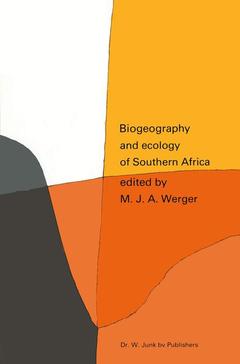Description
Biogeography and Ecology of Southern Africa, Softcover reprint of the original 1st ed. 1978
Monographiae Biologicae Series, Vol. 31
Coordinators: Werger Marinus J.A., van Bruggen A.C.
Language: English
Subject for Biogeography and Ecology of Southern Africa:
Keywords
Fauna; Karoo; Mangrove; Namib; Vegetation; classification; ecology; ecosystem; environment; morphology
Publication date: 08-2014
1444 p. · 15.5x23.5 cm · Paperback
1444 p. · 15.5x23.5 cm · Paperback
Description
/li>Contents
/li>
Southern Africa is certainly not a naturally bounded area so that there are several possibilities for delineating it and concepts about its extent. Wellington* discussed the various possibilities for delineation and suggested that one line stands out more clearly and definitely as a physical boundary than any other, namely the South Equatorial Divide, the watershed between the ZaIre, Cuanza and Rufiji Rivers on the one hand and the Z ambezi, Cunene and Rovuma Rivers on the other. This South Equatorial Divide is indeed a major line of separation for some organisms and is also applicable in a certain geographical sense, though it does not possess the slightest significance for many other groups of organisms, ecosystems or geographical and physical features of Africa. The placing of the northern boundary of southern Africa differs in fact strongly per scientific dis cipline and is also influenced by practical considerations regarding the possibilities of scientific work as subordinate to certain political realities and historically grown traditions. This is illustrated, for example, in such works as the Flora of Southern Africa, where the northern boundary of the area is conceived as the northern and eastern political boundaries of South West Africa, South Africa and Swaziland. Botswana, traditionally included in the area covered by the Flora Zambesiaca, thus forms a large wedge in 'Southern Africa'.
Environment, present and past.- 1 The geomorphology of central and southern Africa.- 2 Climatic indices and classifications in relation to the biogeography of southern Africa.- 3 Rainfall changes over South Africa during the period of meteorological record.- 4 Schematic soil map of southern Africa south of latitude 16° 30’S.- 5 Late Cretaceous and Tertiary vegetation history of Africa.- 6 Quaternary vegetation changes in southern Africa.- Biogeography and ecology.- 7 Biogeographical division of southern Africa.- 8 Capensis.- 9 The Karoo-Namib Region.- 10 The Sudano-Zambezian Region.- 11 The Afromontane Region.- 12 The Afro-alpine Region.- 13 The Indian Ocean Coastal Belt.- 14 The Guineo—Congolian transition to southern Africa.- 15 Primary production ecology in southern Africa.- 16 Megadrilacea (Oligochaeta).- 17 Onychophora.- 18 Arachnida (except Acari).- 19 Acari, by Magdalena.- 20 Myriapoda.- 21 Odonata.- 22 Orthoptera.- 23 Isoptera.- 24 Lepidoptera.- 25 Diptera.- 26 Coleoptera.- 27 Hymenoptera.- 28 Land mollusks.- 29 The Herpetofauna.- 30 Birds.- 31 Mammals.- 32 Patterns of man-land relations.- Biogeography and ecology of special habitats.- 33 Freshwater plants.- 34 Freshwater invertebrates (except molluscs).- 35 Freshwater molluscs.- 36 Freshwater fishes.- 37 Mangrove communities.- 38 Coastal marine habitats.- 39 High termitaria.- 40 The vegetation of heavy metal and other toxic soils.- Conservation.- 41.Ecosystem conservation in southern Africa.- Systematic index.
© 2024 LAVOISIER S.A.S.




